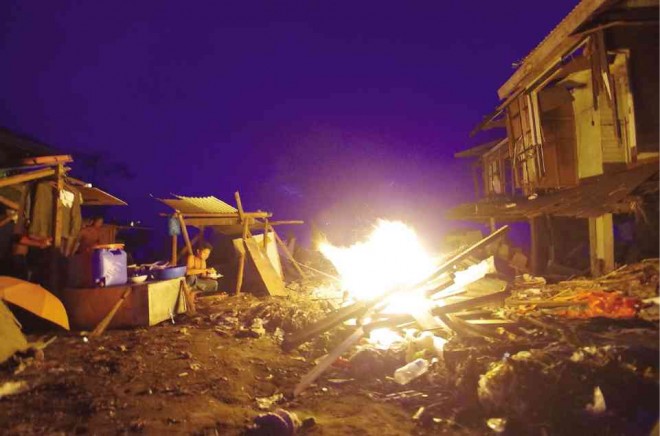Volunteers haunted by ruin, deaths

A MAN sets fire to a pile of debris in one of the most devastated parts of Tacloban City to keep warm and ward off criminal elements as he keeps watch over the area that he used to call home. RICHARD BALONGLONG/INQUIRER NORTHERN LUZON
The death and destruction that Supertyphoon “Yolanda” and an ineffective government response left in Tacloban City played out like a horror movie to volunteers from other places who had gone to the devastated city to help.
Take the cases of Ron Pelejo, a government worker in Quezon province, and Rodrigo Duterte, the mayor of Davao City.
“With the massive devastation that I saw, it’s a mixed feeling,” Pelejo said. “I’m happy that I was able to help,” he said. “But I also know that my Christmas will be a sad one this year,” he said in a phone interview as he was returning home from a humanitarian mission in Tacloban.
“I think God was somewhere else when the typhoon hit,” said Duterte, talking to reporters in Davao City shortly after returning from Tacloban also on a humanitarian mission. “Dead bodies were all over and until now, many people have no food, no water,” said the mayor, known to be a tough guy, as tears formed in his eyes.
Duterte continued his narration of what he saw in Tacloban, taking a deep breath. “The people there just stared at the sky in hopelessness,” he said, his voice cracking.
Article continues after this advertisementPelejo, 22, is one of dozens of volunteers from Quezon who went to the devastated parts of Eastern Visayas.
Article continues after this advertisementAsked to describe what he saw, he groped for words.
“I thought I’ve seen it all on TV and Facebook,” said Pelejo. “It is different out there. The grim reality and horror of it all stared at you in the face,” he said.
Duterte had gone to Tacloban and handed P8 million in cash from the Davao City government to survivors in Samar and Leyte provinces.
He had also brought in volunteers to help in search and relief operations.
Pelejo said he thought the destruction that he had seen in Tacloban happen only in the movies.
“I can’t imagine myself fighting for survival in the midst of the deluge. I shudder at the thought,” he added.
While in Tacloban, Pelejo said he fought the urge to take a “selfie” with his mobile phone camera.
“With the panorama of wrecked lives, a selfie is a big no-no. Tacloban is a place for human compassion, not a place for tourists,” he said.
He, however, took pictures of the destruction to remind him and the other volunteers that there is still much work to do.
Janet Geneblazo-Buelo, Quezon public information officer who also joined the humanitarian mission, said more than 40 volunteers aboard a bus were all “emotionally devastated.”
“We have all realized that we have no more right to complain about our little inadequacies in life compared to the grave anguish and sufferings of the thousands of typhoon victims,” she said.
Mario Medina, 34, who came to help unload goods from a relief truck that was sent to Tacloban, said he cried when he saw bodies lying on the streets, dazed and confused survivors, houses gone, and entire communities wiped out.
“When a young boy begged for food or water, I immediately handed him a pack of biscuit and bottled water. He looked like my youngest son. I even scratched his curly hair like the way I often do to my own boy,” he said in an interview in an eatery along Maharlika Highway in Lucena City.
Medina said he texted his wife in Manila to sort out usable clothes, buy cans of sardines and packs of noodles. He said he would bring the goods back to Leyte on his next trip.
“It will be our token symbol of sympathy to typhoon victims. I want to give more, even adopt orphaned children but I’m not rich. But I know there are many Good Samaritans out there,” he said.
“It was terrible, terrible, terrible,” said Quezon Governor David Suarez repeatedly on the phone, describing how he felt when he came to visit Tacloban.
“I was jolted from my sleep last night. The horrific images of devastation and human misery that we left in Leyte kept on flashing back,” he said. With a report by Judy Quiros, Inquirer Mindanao